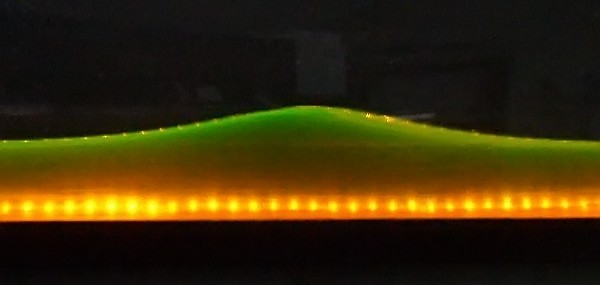|
Solitons
In mathematics and physics, a soliton or solitary wave is a self-reinforcing wave packet that maintains its shape while it propagates at a constant velocity. Solitons are caused by a cancellation of nonlinear and dispersive effects in the medium. (Dispersive effects are a property of certain systems where the speed of a wave depends on its frequency.) Solitons are the solutions of a widespread class of weakly nonlinear dispersive partial differential equations describing physical systems. The soliton phenomenon was first described in 1834 by John Scott Russell (1808–1882) who observed a solitary wave in the Union Canal in Scotland. He reproduced the phenomenon in a wave tank and named it the " Wave of Translation". Definition A single, consensus definition of a soliton is difficult to find. ascribe three properties to solitons: # They are of permanent form; # They are localized within a region; # They can interact with other solitons, and emerge from the collision unchange ... [...More Info...] [...Related Items...] OR: [Wikipedia] [Google] [Baidu] |
Soliton (optics)
In optics, the term soliton is used to refer to any optical field that does not change during propagation because of a delicate balance between nonlinear and linear effects in the medium. There are two main kinds of solitons: * spatial solitons: the nonlinear effect can balance the diffraction. The electromagnetic field can change the refractive index of the medium while propagating, thus creating a structure similar to a graded-index fiber. If the field is also a propagating mode of the guide it has created, then it will remain confined and it will propagate without changing its shape * temporal solitons: if the electromagnetic field is already spatially confined, it is possible to send pulses that will not change their shape because the nonlinear effects will balance the dispersion. Those solitons were discovered first and they are often simply referred as "solitons" in optics. Spatial solitons In order to understand how a spatial soliton can exist, we have to make some consi ... [...More Info...] [...Related Items...] OR: [Wikipedia] [Google] [Baidu] |
Sine-Gordon Equation
The sine-Gordon equation is a nonlinear hyperbolic partial differential equation in 1 + 1 dimensions involving the d'Alembert operator and the sine of the unknown function. It was originally introduced by in the course of study of surfaces of constant negative curvature as the Gauss–Codazzi equation for surfaces of curvature −1 in 3-space, and rediscovered by in their study of crystal dislocations known as the Frenkel–Kontorova model. This equation attracted a lot of attention in the 1970s due to the presence of soliton solutions. Origin of the equation and its name There are two equivalent forms of the sine-Gordon equation. In the ( real) ''space-time coordinates'', denoted (''x'', ''t''), the equation reads: : \varphi_ - \varphi_ + \sin\varphi = 0, where partial derivatives are denoted by subscripts. Passing to the light-cone coordinates (''u'', ''v''), akin to ''asymptotic coordinates'' where : u = \frac, \quad v = \frac, the equation takes ... [...More Info...] [...Related Items...] OR: [Wikipedia] [Google] [Baidu] |
Integrable System
In mathematics, integrability is a property of certain dynamical systems. While there are several distinct formal definitions, informally speaking, an integrable system is a dynamical system with sufficiently many conserved quantities, or first integrals, such that its behaviour has far fewer degrees of freedom than the dimensionality of its phase space; that is, its evolution is restricted to a submanifold within its phase space. Three features are often referred to as characterizing integrable systems: * the existence of a ''maximal'' set of conserved quantities (the usual defining property of complete integrability) * the existence of algebraic invariants, having a basis in algebraic geometry (a property known sometimes as algebraic integrability) * the explicit determination of solutions in an explicit functional form (not an intrinsic property, but something often referred to as solvability) Integrable systems may be seen as very different in qualitative character from mor ... [...More Info...] [...Related Items...] OR: [Wikipedia] [Google] [Baidu] |
Inverse Scattering Transform
In mathematics, the inverse scattering transform is a method for solving some non-linear partial differential equations. The method is a non-linear analogue, and in some sense generalization, of the Fourier transform, which itself is applied to solve many linear partial differential equations. The name "inverse scattering method" comes from the key idea of recovering the time evolution of a potential from the time evolution of its scattering data: inverse scattering refers to the problem of recovering a potential from its scattering matrix, as opposed to the direct scattering problem of finding the scattering matrix from the potential. The inverse scattering transform may be applied to many of the so-called exactly solvable models, that is to say completely integrable infinite dimensional systems. Overview The inverse scattering transform was first introduced by for the Korteweg–de Vries equation, and soon extended to the nonlinear Schrödinger equation, the Sine-Gordon equ ... [...More Info...] [...Related Items...] OR: [Wikipedia] [Google] [Baidu] |
Exactly Solvable Model
In mathematics, integrability is a property of certain dynamical systems. While there are several distinct formal definitions, informally speaking, an integrable system is a dynamical system with sufficiently many conserved quantities, or first integrals, such that its behaviour has far fewer degrees of freedom than the dimensionality of its phase space; that is, its evolution is restricted to a submanifold within its phase space. Three features are often referred to as characterizing integrable systems: * the existence of a ''maximal'' set of conserved quantities (the usual defining property of complete integrability) * the existence of algebraic invariants, having a basis in algebraic geometry (a property known sometimes as algebraic integrability) * the explicit determination of solutions in an explicit functional form (not an intrinsic property, but something often referred to as solvability) Integrable systems may be seen as very different in qualitative character from more ... [...More Info...] [...Related Items...] OR: [Wikipedia] [Google] [Baidu] |
Nonlinear Optics
Nonlinear optics (NLO) is the branch of optics that describes the behaviour of light in ''nonlinear media'', that is, media in which the polarization density P responds non-linearly to the electric field E of the light. The non-linearity is typically observed only at very high light intensities (when the electric field of the light is >108 V/m and thus comparable to the atomic electric field of ~1011 V/m) such as those provided by lasers. Above the Schwinger limit, the vacuum itself is expected to become nonlinear. In nonlinear optics, the superposition principle no longer holds. History The first nonlinear optical effect to be predicted was two-photon absorption, by Maria Goeppert Mayer for her PhD in 1931, but it remained an unexplored theoretical curiosity until 1961 and the almost simultaneous observation of two-photon absorption at Bell Labs and the discovery of second-harmonic generation by Peter Franken ''et al.'' at University of Michigan, both shortly after the con ... [...More Info...] [...Related Items...] OR: [Wikipedia] [Google] [Baidu] |
Refractive Index
In optics, the refractive index (or refraction index) of an optical medium is a dimensionless number that gives the indication of the light bending ability of that medium. The refractive index determines how much the path of light is bent, or refracted, when entering a material. This is described by Snell's law of refraction, , where ''θ''1 and ''θ''2 are the angle of incidence and angle of refraction, respectively, of a ray crossing the interface between two media with refractive indices ''n''1 and ''n''2. The refractive indices also determine the amount of light that is reflected when reaching the interface, as well as the critical angle for total internal reflection, their intensity (Fresnel's equations) and Brewster's angle. The refractive index can be seen as the factor by which the speed and the wavelength of the radiation are reduced with respect to their vacuum values: the speed of light in a medium is , and similarly the wavelength in that medium is , where ''� ... [...More Info...] [...Related Items...] OR: [Wikipedia] [Google] [Baidu] |
Pycnocline
A pycnocline is the cline or layer where the density gradient () is greatest within a body of water. An ocean current is generated by the forces such as breaking waves, temperature and salinity differences, wind, Coriolis effect, and tides caused by the gravitational pull of celestial bodies. In addition, the physical properties in a pycnocline driven by density gradients also affect the flows and vertical profiles in the ocean. These changes can be connected to the transport of heat, salt, and nutrients through the ocean, and the pycnocline diffusion controls upwelling. Below the mixed layer, a stable density gradient (or pycnocline) separates the upper and lower water, hindering vertical transport. This separation has important biological effects on the ocean and the marine living organisms. However, vertical mixing across a pycnocline is a regular phenomenon in oceans, and occurs through shear-produced turbulence. Such mixing plays a key role in the transport of nutrients. P ... [...More Info...] [...Related Items...] OR: [Wikipedia] [Google] [Baidu] |
Seabed Topography
The seabed (also known as the seafloor, sea floor, ocean floor, and ocean bottom) is the bottom of the ocean. All floors of the ocean are known as 'seabeds'. The structure of the seabed of the global ocean is governed by plate tectonics. Most of the ocean is very deep, where the seabed is known as the abyssal plain. Seafloor spreading creates mid-ocean ridges along the center line of major ocean basins, where the seabed is slightly shallower than the surrounding abyssal plain. From the abyssal plain, the seabed slopes upward toward the continents and becomes, in order from deep to shallow, the continental rise, slope, and shelf. The depth within the seabed itself, such as the depth down through a sediment core, is known as the “depth below seafloor.” The ecological environment of the seabed and the deepest waters are collectively known, as a habitat for creatures, as the “benthos.” Most of the seabed throughout the world's oceans is covered in layers of marine sediments ... [...More Info...] [...Related Items...] OR: [Wikipedia] [Google] [Baidu] |
Internal Wave
Internal waves are gravity waves that oscillate within a fluid medium, rather than on its surface. To exist, the fluid must be stratified: the density must change (continuously or discontinuously) with depth/height due to changes, for example, in temperature and/or salinity. If the density changes over a small vertical distance (as in the case of the thermocline in lakes and oceans or an atmospheric inversion), the waves propagate horizontally like surface waves, but do so at slower speeds as determined by the density difference of the fluid below and above the interface. If the density changes continuously, the waves can propagate vertically as well as horizontally through the fluid. Internal waves, also called internal gravity waves, go by many other names depending upon the fluid stratification, generation mechanism, amplitude, and influence of external forces. If propagating horizontally along an interface where the density rapidly decreases with height, they are specifically ... [...More Info...] [...Related Items...] OR: [Wikipedia] [Google] [Baidu] |






